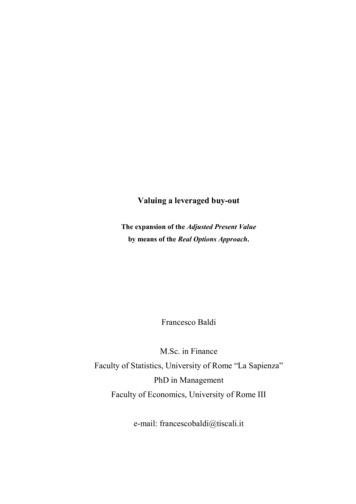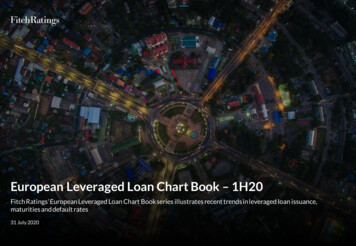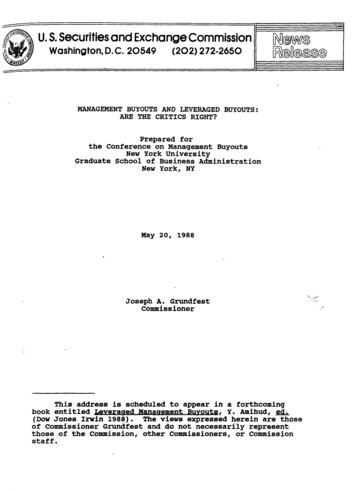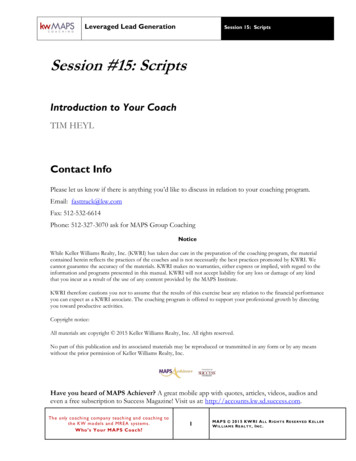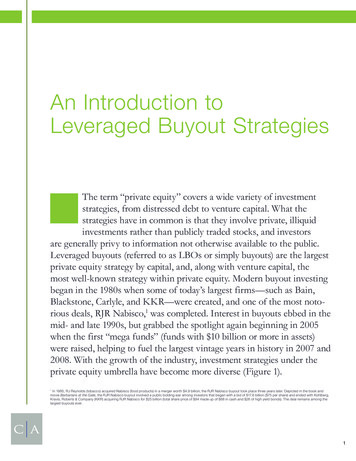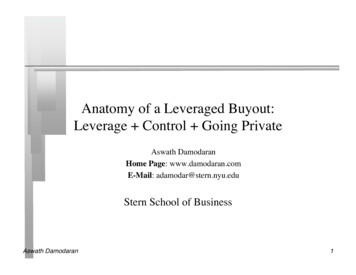
Transcription
Presenting a live 90-minute webinar with interactive Q&AStructuring Leveraged Finance Transactionsfor Private Equity Acquisitions:Key Loan Terms and TrendsTHURSDAY, DECEMBER 18, 20141pm Eastern 12pm Central 11am Mountain 10am PacificToday’s faculty features:Joseph W. Price, Member, Mintz Levin Cohn Ferris Glovsky and Popeo, New YorkEllen M. Snare, Partner, King & Spalding, New YorkThe audio portion of the conference may be accessed via the telephone or by using your computer'sspeakers. Please refer to the instructions emailed to registrants for additional information. If youhave any questions, please contact Customer Service at 1-800-926-7926 ext. 10.
Tips for Optimal QualityFOR LIVE EVENT ONLYSound QualityIf you are listening via your computer speakers, please note that the qualityof your sound will vary depending on the speed and quality of your internetconnection.If the sound quality is not satisfactory, you may listen via the phone: dial1-866-328-9525 and enter your PIN when prompted. Otherwise, pleasesend us a chat or e-mail sound@straffordpub.com immediately so we can addressthe problem.If you dialed in and have any difficulties during the call, press *0 for assistance.Viewing QualityTo maximize your screen, press the F11 key on your keyboard. To exit full screen,press the F11 key again.
Continuing Education CreditsFOR LIVE EVENT ONLYFor CLE purposes, please let us know how many people are listening at yourlocation by completing each of the following steps: In the chat box, type (1) your company name and (2) the number ofattendees at your location Click the word balloon button to send
Structuring Leverage FinanceTransactions for Private EquityAcquisitions: Key Loan Termsand TrendsDecember 18, 2014Joseph Price, MemberMintz, Levin, Cohn, Ferris,Glovsky and Popeo, P.C.666 Third AvenueNew York, NY 10017jwprice@mintz.comEllen M. Snare, PartnerKing & Spalding LLP1185 Avenue of the AmericasNew York, NY 10036esnare@kslaw.com
Leveraged Buyout Financing – Typical StructureRollover SellersManagementSponsorTopco(Non-Credit Party)Subordinated Notes(structural/contractual subordination)Holdco(Guarantor)Downstream guarantyof Bank Debt100% pledge of Opco stockOpCo(Borrower)Upstreamguaranty ofBank DebtUpstreamguaranty ofBank Subsidiary(Delaware)(Guarantor)Subordinated Notes(contractual subordination)Bank Debt (term/revolver) Security in assets andsubsidiary stock pledgeSenior High-Yield Notes(typically unsecured/sometimes lien subordination)Subsidiary(France)(Non-Credit Party)ASSETS of Holdco (if any) and STOCK of Opco pledged by Holdco in support of Holdco downstream GUARANTYASSETS of Opco and STOCK of Subsidiaries pledged in support of borrowings under CREDIT AGREEMENT by OpcoASSETS of domestic subsidiaries pledged in support of upstream GUARANTIES by such Subsidiaries5
Types of Credit FacilitiesA Typology of LoansLoansFirst LienSenior SecuredSecond LienSenior uity6
Senior Credit Facilities Term Loans– Closing Date Term Loans– Delayed Draw Term Loans Revolving Loans– Letters of Credit– Swingline Incremental Facilities ("Accordions")– Advantage: No Lender consent required– Most Favored Nation (MFN) Pricing typically applies– Types: Fixed vs. Unlimited7
Unitranche FacilitiesSenior secured debt on the borrower’s capitalstructureWhat isUnitranche?Lenders separately agree among themselvesto create first and last out tranchesOne Credit Agreement All lenders party to one Credit Agreement One class of loans/ one blended interest rate for alllenders (as far as borrower is concerned) One set of covenants and defaults Voting subject to majority (or supermajority)8
Advantages of Unitranche Facilities9
Second Lien Loans Loans secured by a second priority lien on the assets of the Borrowerand Guarantors Typically agree to be subordinated with respect only to lien priorities andnot payment priorities May be cross-defaulted (subject to cure/grace period) to First Lien loansor cross-accelerated to First Lien Loans Generally no amortization required and prepayments only made to theextent First Lien prepayment requirements have been satisfied or FirstLien Lenders decline payments Maturity date is typically 6 months to 1 year beyond First Lien maturity10
Second Lien Loans Often subject to prepayment premiums for repayments within a certaintimeframe after closing– Market is moving toward just requiring premiums in connection with RepricingTransactions Repricing Transactions are:– Prepayments made with the proceeds of any indebtedness with an interest rate belowthe rate charged on the existing debt; or– Amendments to the existing debt which have the effect of reducing pricing on theexisting loan11
Mezzanine Loans Traditional mezzanine loans are borrowed by the holdingcompany/parent of the senior loan borrower–Generally preferred by senior lenders because it results in structuralsubordination Current market practice has the mezzanine loans borrowed by sameborrower as senior loan borrower Mezzanine loans are typically unsecured and subject to expresssubordination agreements (resulting in contractual subordination)12
Mezzanine Loans Common terms– Mezzanine loan pricing is significantly higher than senior loan pricing given the greaterrisk incurred by unsecured creditors, although rates have trended downward– Often a fixed rate of interest rather than a floating LIBOR linked loan– A portion of the interest on mezzanine loans is often payable in kind at Borrower’s option Note that PIK interest presents AHYDO issues if the term of the mezzanine loan exceeds 5 years– Term of mezzanine loans typically set at 6 months to 1 year beyond the maturity date ofsenior loans– Generally subject to prepayment premiums; sometimes make-whole premiums, althoughprepayment premiums have been reduced recently– Trend towards carve-outs for change of control and "transformative transactions"– Mezzanine lenders often given equity and/or sometimes warrants in borrower– Mezzanine lenders often receive non-voting board observer rights13
Incremental/Refinancing Tranches Most large cap deals and many mid-market facilities permit borrowers toincur incremental and/or refinancing indebtedness as existing facilityincreases or new tranches of debt that are pari passu, senior secured,unsecured, or high yield note issuances Form of intercreditor at closing is often negotiated to allow for additionaltranches and types of debt to be added14
Equity Contributions Lenders typically require at least 40% of capital structure to becontributed in the form of cash equity by the Sponsor–Management equity rollover often included for purposes of calculatingsuch 40% Lenders generally have approval rights over:– The terms of any preferred equity invested at closing Note – cannot have any mandatory redemption rights other than as a result of achange of control or asset sale– The identify of any non-affiliate/non-management equity co-investor atclosing15
Structuring Guarantees Important to identify early on in the debt financing process whichentities in the corporate structure will provide guarantees andcollateral for the credit facility Consider tax implications, particularly in the case of foreignsubsidiaries. For US income tax purposes, a guarantee by a foreignsubsidiary or a pledge of more than 65% of the voting equity interestsof a foreign subsidiary may cause the earnings of such foreignsubsidiary to be deemed to be paid as a dividend to the US parent(thereby potentially increasing US tax obligations by the amount of thedeemed dividend although it never actually occurred) Consider regulatory issues that would restrict guarantees (such asprohibitions on PCs guaranteeing obligations in a healthcare deal andcaptive insurance subsidiaries being restricted from providingguarantees) Consider other company specific issues and operational restrictionsthat may prevent guarantees16
Unrestricted SubsidiariesWhat Entities are Subject to the Covenants, Events of Default andRepresentations and Warranties? Restricted Subsidiaries/Unrestricted Subsidiaries– Consider excluding “Immaterial Subsidiaries”: i.e., individually less than 5% CTA or5% Total Revenues and collectively less than 10% of CTA and Total Revenues– Consider excluding “Unrestricted Subsidiaries”: Entities on a schedule to the Credit Agreement at Closing Other entities identified by Borrower from time to time, provided after giving effectto designation, would otherwise be in compliance with covenants (financialcovenants, permitted investments, etc ) Company may want to engage in unrelated businesses Way to minimize impact of negative EBITDA attributable to entities17
Structuring Collateral Package Most loans are secured by "substantially all" of the personal propertyof the applicable credit parties (including equity interests andpromissory notes) Loans may also be secured by owned real property Depending on the importance of certain leased locations, lenders mayalso require leasehold mortgages, although not customary Typical exceptions to the collateral package (or perfectionrequirements) include:– Payroll, employee benefits, trust and escrow accounts; deposit accounts with a deminimus value– Assets the pledge of which would violate applicable law, regulation or contractualrestriction– Motor vehicles and other equipment subject to certificates of title– Owned real estate with a de minimus value– Other assets deemed to be immaterial in the discretion of the Administrative Agent18
Acquisition Financing TimelineAcquisition financings can run from a few weeks to several months. Thistimeline assumes that this is a broadly syndicated deal (instead of a “clubdeal”) and a period of 8 weeks from the commencement of the transactionthrough the closing. Timeline is also subject to any necessary regulatoryapproval.Initiation (Weeks 1-3)Sponsor approaches financialinstitutions to fund anacquisitionSponsor choosesadministrative agent andarranger to providecommitments and to conductthe syndication process.Sponsor provides financialinformation and due diligencematerial to financial institutionsafter signing a non-disclosureagreement.Administrative agent and itscounsel sign off on thediligence.19
Acquisition Financing Timeline (cont’d.)Acquisition Documentation and Commitment PaperDocumentation (Weeks 2-3)Administrative agent’s counsel andsponsor’s counsel negotiatecommitment papers concurrentlywith the negotiation of theacquisition agreement.Administrative agent, arrangersand sponsor or its acquisitionvehicle sign commitment paperssimultaneously with the signing ofthe acquisition agreement.Syndication Process (Weeks 3-8 )Sponsor and target provideinformation so that the arrangerscan prepare an informationmemorandum.Arranger preparesinformation memorandum.Arrangers go on “road show”to discuss informationmemorandum with potentiallenders.20
Acquisition Financing Timeline (cont’d.)Loan Documents and Satisfying the Conditions toFund and for the Acquisition (Weeks 3-8)Administrative agent’s counsel andsponsor’s counsel negotiate theloan documents.Lenders provide any comments.Administrative agent postdocuments for syndicate lenders.Loan documents are finalized andthe conditions to fund and forconsummation of the acquisitionare satisfied except for executionand delivery of the final loandocuments.Closing/Signing (Week 8)The loan documents are executedand delivered and all conditions tothe funding and the acquisition aresatisfied.Funding occurs and the acquisitionis consummated.21
Acquisition Financing Timeline (cont’d.)Post-ClosingBorrower and administrative agentwork collaboratively to satisfy anypost-closing conditions.Arrangers continue to syndicateloans (if not fully syndicated).22
Evolution of Loan ield StyleCovenants in Term BLoansSunGardConditionalityBuilder Basketsand tmentsAcquisitionsPrecaps23
Terms Borrowed from High Yield BondIndentures Unrestricted Subsidiaries Incurrence Flexibility Ratio debt: leverage ratio vs. coverage ratio Build Baskets: Cumulative unswept excess cash flow vs. 50% ofcumulative consolidated net income Acquisitions permitted with no dollar cap (except non-Loan Partyacquisitions) Accounting definitions Grower baskets (greater of dollar amount and a percentage of totalassets or Consolidated EBITDA) Increasing conformity of credit facility covenants with high yieldcovenants24
Trends - Financial Covenants Covenant Lite‒ Term Loan B: No financial maintenance covenants‒ Revolver: Springing covenant (total or first lien secured net leverage ratio) Triggered based on Revolver usage (20-33%) Treatment of Letters of Credit (exclusion of cash collateralized, inclusion of L/Csover threshold) Testing‒ No Term Loan default based on Financial Covenant (unless revolver accelerates) Fewer Covenants Cushions increasing Equity Cures‒ Increased cap‒ Credit for deleveraging in some or subsequent quarters25
Trends - Acquisition Financing Conditionality Limited Specified Conditions Synching of Financing Conditions with Acquisition Agreement Sungard Reps limited to Acquisition Agreement reps that give Sponsor right to terminate andSpecified Reps (list has become standardized); no “no default” condition Limited Collateral Deliveries (UCC financing statements, certificated securities) Application for financings of add-on acquisitions Company MAC Approval of Acquisition Agreement Financial Information Deliveries Termination Date No separate acquisition-related conditions Marketing Period26
Trends – Commitment Papers Sponsor Precedent/Documentation Principles‒ Specified precedent agreement‒ Loan documents to be negotiated in good faith; changes to reflect operational andstrategic requirements, size, industry of Borrower27
Migration of Large-Cap Terms to Middle MarketDeals Large cap terms appearing in middle market commitment lettersinclude:– Limitations on expense reimbursement Contingent on closing Fee estimate or cap– The specification that sponsor’s counsel will be responsible for drafting the loandocumentation Use of sponsor precedent– Looser “SunGard" conditionality The types of collateral required to be delivered at closing are becoming morelimited (i.e., UCC collateral and stock certificates) Becoming more common for middle market sponsors to draft theinitial commitment papers28
Migration of Large-Cap Terms to Middle MarketDeals Large-cap terms that are now appearing in middle market loanagreements include:– Financial performance measurements EBITDA– Inclusion of pro forma costs savings, synergies, optimization expenses projected by borrower (modifiedS-X standard), but generally capped at percentage of adjusted EBITDA Net Debt– Unrestricted cash– No cap vs. caps The percentages of ECF required to prepay loans and the related step-downsbased on financial ratio tests are negotiated No cap ex covenant– Incremental facilities Conditions include:– Pro forma compliance with financial covenants29
Migration of Large-Cap Terms to Middle MarketDeals Size of incremental facility generally (but not always) capped in lower middlemarket Uncapped incremental facilities subject to ratio based limiter No Default – subject to SunGard conditionality for acquisitions MFN protection– 50 bps standard– Sunset (sometimes)– yield formulas for calculation– Equity cure rights (terms have become standardized) Limited number of cures & limited number of quarters in any year Limited to amount needed to cure financial covenant default– Amend & extend provisions Ability to extend maturity and change economic terms of any facility with consentof just extending lenders– Ratio/incurrence based debt and restricted payment (including repayment of secondlien and/or subordinated debt) flexibility30
Migration of Large-Cap Terms to Middle MarketDeals– Sponsor affiliate loan assignments generally capped at 20-30% of aggregate amount of term loans at time of purchase voting rights (other than issues that unfairly impact sponsor lender) limited numerosity issues in a bankruptcy– Borrower debt buybacks/Dutch auctions repurchase debt at below par prices avoids pro rata sharing among lenders Sometimes "open-market" repurchases permitted– Builder baskets used for additional restricted payments, permitted acquisitions, prepayments of second lienand/or sub debt, investments and capital expenditures sometimes a “starter” basket typically based on % of retained ECF or % of CNI plus increase in value of investmentsand/or sale of investments purchased with builder baskets31
Migration of Large-Cap Terms to Middle MarketDeals– Grower baskets used for additional restricted payments, permitted acquisitions, prepayments of second lienand/or sub debt, investments and capital expenditures typically based off of a calculation of revenue, total assets of EBITDA– Lender/competitor blacklists– Refinancing facilities Ability to refinance any facility in whole or in part with new debt issuances32
Continued and Increased Presence ofAlternative Lenders Helps Drive Middle MarketActivity Customization of financing structures More flexibility for different structures and features– Unitranche, low or no amort, PIK interest, complex collateral issues With committed facilities, challenges include getting same degree of“SunGard” conditionality and hence more attention needs to be paidto the M&A dynamic and interplay (e.g., required financial conditionsto closing) Alternative lenders often require equity co-invest We often see multiple alternative lenders competing for deals33
Dec 18, 2014 · Leveraged Buyout Financing – Typical Structure Subsidiary (Illinois) (Guarantor) Subordinated Notes (contractual subordination) ASSETS of Holdco (if any) and STOCK of Opco pledged by Holdco in support of Holdco downstream GUARANTY ASSETS of Opco and STOCK of Subsidiaries pledge
